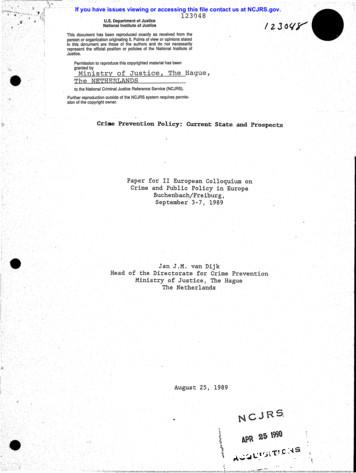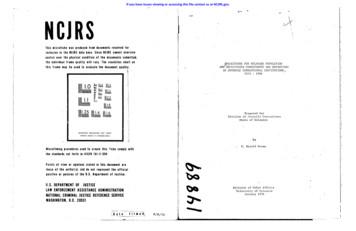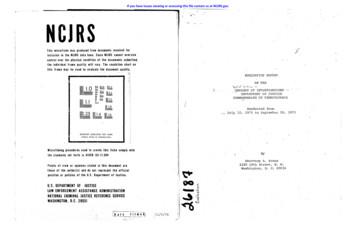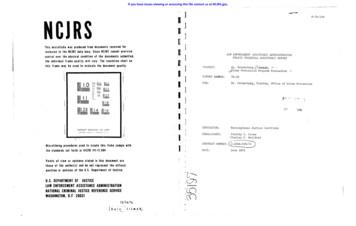EDUCATION HANDBOOK - NCJRS
If you have issues viewing or accessing this file, please contact us at NCJRS.gov.EDUCATION HANDBOOKA Resource and Reference Guide For Education and LeisureActivity Managers and Personnel in the Federal Prison SystemEducation Services SectionFederal Prison SystemWashington, D. C.June, 1978, . . . , .,. .
:eI
------000.0EDUCATION SERVICES HANDBOOKTABLE OF CONTENTSSectionPage100 Introduction100.0 - 100.6101 Purpose of Handbook100.0102 Mission100.0 - 100.1103 Organization Charts100.0 - 100.6103.1 Federal Prison System100.2103.2 Correctional Programs Division100.3103.3 Inmate Programs Services Branch100.4103.4 Education Services100.5103.5 A Typical Education DepartmentOrganization Chart100.6200 Administrative Responsibilities and Procedures201 Goals, Definitions, and Guidelines200.0 - 200.37200.0 - 200.3201.1 How to Handle Some Typical Problems200.1 - 200.2201.2 Annual Plans of Action200.3202 Admission and Orientation Responsibilities202.1 Interviewing200.4 - 200.9200.4202.1.1 Education Data200.4202.1.2 Personal History Data Form BP-6200.4 - 200.6202.1.3 Education Handbooks200.6202.2 Testing200.6 - 200.8202.3 Unit Education Advisor/Representative200.8 - 200.9202.4 Optional Programming200.9
000.1203 Inmate Program Reporting System (IPRS)200.9 - 200.10204 Supervision of Programs200.10 - 200.17204.1 Determining the Need for Programs200.10 - 200.11204.2 Model Program200.11204.2.1 Model Program Chart200.12204.3 Evaluating the Effectiveness of Programs200.13 - 200.15204.3.1 Internal Evaluation200.13 - 200. 14204.3.2 External Evaluation200.14 - 200. 15204,4 Evaluating the Effectiveness of Staff200.15204.4.1 Contract Staff200.15204.4.2 Civil Service Staff200.16 - 200.17204.5 Staff Meetings200.17 - 200.18205 Budget Planning and Management200. 18 - 200.29205.1 Sources of Education Funds200.18 - 200.20205.2 Zero Based Budgeting200.20 - 200.21205.3 Preparing an S&E Budget200.21 - 200.26205.3.1 Budget Request Form Education Cost Center200.22205.3.2 Education Budget Request Part-Time &ConSUltant Services200.23205.3.3 Education Budget Cost Centers - Summary ofRequirements - Part-Time and Fee Contractors/ConSUltants200.24205.3.4 A Suggested Method for BudgetPreparat on205.4 Preparing an FPI Funded Vocational Training Budget200.25 - 200.26200.26 - 200.29205.4.1 Vocational Training Budget Request - A200.27205.4.2 Vocational Training Budget Request - B200.28
000.2206 Auxiliary Responsibilities200.29 - 200.32206.1 Incoming Publications200.30206.2 Inmate Manuscripts200.30 - 200.31206.3 Special Purchase Orders &Mail Room Permits200.31 - 200.32206.4 Staff Duty Roster200.32207 Custody and Security Responsibilities200.32 - 200.33208 Membership in Professional Organizations200.33 - 200.34209 Staff Training200.34 - 200.37209.1 Civil Service Courses200.34 - 200.35209.2 Staff Training Center Courses200.35209.3 Institution Conducted In-Service Courses200.35 - 200.36209.3.1 Departmental In-Service Training200.36 - 200.37209.4 Other Sources of Training300 Program Scope and Content301 The Learning Resource Center200.37300.0 - 300.30300.0 -300.1301.1 Placement Test & Individual Prescriptions300.1301.2 Interest Survey & Profile of Student Needs300.1 -300.2302 GED Program300.2 -300.4303 Postsecondary Programs300.4 -300.7304 Study Release300.7 -300.8305 Occupational Education Programs300.8 -300.11305.1 Exploratory Training300.9305.2 Vocational Training300.9305.3 On-the-Job Training300.10305.4 Apprentice Training300.10 - 300.11
000.3306 Correspondence Courses3'JO.11 -307 Library Services300.13 - 300.14300.13307.1 Physical Layout of Library300.13307.2 Materials Available Through InmateLibrary Services300.13307.3 Sources of Library Books300.13 - 300.14307.4 Spanish Language and Other Non-EnglishPublications.300.14300.14 - 300.17308 Legal Libraries308.1 Physical Layout and Location of LegalLibrary300.15308.2 Hours of Operation300.15308.3Staffin and Responsibility for Legal300.15 - 300.16Library308.4 Content of Legal Library300.16 - 300.1730B.5 Reproduction of Legal Reference Material300.17309 Leisure Activities300.17 - 300.22309.1 Objectives300.18309.2 Athletics300.18 - 300.20309.3 Cultural and Social Activities300.20309.4 Movies and Stage Shows300.20 - 300.21309.5 Hobbycraft300.21309.6 Inmate Involvement300.21 - 300.22309.7 Staffing Patterns300.22310 Social Education300.23 - 300.25310.1 Definition and Purpose300.23310.2 Role of Education Services in Social Education300.23310.3 Role of Leisure Activities in Social Education300.24
000.4310.4 Role of Psychology andin Social EducationCh plaincyServices300.24310.5 Staff Modeling300.24310.6 Role of Social Education Coordinator300.25311 Pre-Release Preparation300.25 - 300.27312 Special Programs300.27 - 300.30312.1 Artist-in-Residence300.27 - 300.28312.2 Artists-in-Prison (Performing Arts)300.28312.3 Visiting Room Programs300.28 - 300.30Appendix I -Course Offerings400.0 - 400.13Appendix II - List of Education Staff500.0 -500.38Appendix III - Resource Materials600 . 0 -600 . 9Appendix IV - Education Related Policy Statements700.0 -700.2
100.0100. INTRODUCTION101Purpose ofHandboo This publication is designed to serve as a resource handbook for Education Supervisors and Assistant Supervisors. Everyeffort has been made to make the handbook as comprehensive aspossible covering every area of a manager's responsibility insofar as it relates to the operation of an Education Department.It is the overall policy of the Bureau of Prisons to providein each institution, as comprehensive an education, training andleisure activity program as space and resources permit. This handbook describes the type of activities which should appropriatelytake place in each federal correctional institution in order tomeet this goal.In addition to being a resource book this handbook is intended to be a "how to do itll guide for enterprising educationmanagers who wish to establish meaningful programs.Thls handbook also contains all current Bureau Policy Statements which relate to the responsibilities of an Education Supervisor, and the effective management of programs and personnel.The handbook is directed. primarily toward education managers;however, teachers and leisure activity staff can also find it useful.Publication of this handbook is not intended as a one timeevent. The Education Section of the Central Office plans to review and revise the handbook as often as necessary so that it willremain complete and up-to-date. Pages are numbered in a mannerto facilitate required modifications. In keeping with this objective, suggestions from field personnel are always welcome. Suggestions for additions changes or revisions in the handbook shouldbe forwarded to the Central Office, through the appropriate Regional Education Administrator. Regional Administrators are in vited to comment on these as well as their own suggestions.102 MissionThe primary mission of the Bureau of Prisons is to protectsociety by carrying out judgments imposed by Federal Courts. TheBureau's mission is to develop programs based on a balanced philosophy that recognizes that punishment, deterrence, incapacitation
100.1and access to opportunities for self-improvement are all validpurposes of incarceration. The Bureau's basic objectives include:Providing a safe and humane environment for inmates andstaff.Increasing the number of inmates who achieve a successfuladjustment upon release to the community by offering offenders a wide variety of opportunities for work, jobtraining, education and counseling.A secondary mission of the Bureau is to prG ide lecdership andassistance to state and local correctional agencies when requestedto do so.The goal of the Education Services within the Federal PrisonSystem is to assist inmates to acquire maximum post-release employability by providing occupationally oriented programs. Thefulfillment of this objective requires that Education Departmentsoffer education and training opportunities comparable to thoseavailable in the free world.103 Or9A.n i zation Cha rtsThe following charts which immediately follow this section describe the administrative organization of the Federal Bureau ofPrisons and those administrative units which directly impact Education Services in the Bureau.Federal Prison System103.2 Correctional Programs Division103.3 Inme e Program Services Branch103.4 Education Services103.5 A Typical Education Department Organization Chart103.1L.- .
- ----- --
eFEDERAL PRISON S'YSTEM103.1!DEPIRTMEHT OF JUSTICETHE ATTORNEY GENERALDEPUTYATTORNEY GEHERA -------------------,IIIBUREAU OF PRISONSDIRECTOR:FEDERAL PRISONIIINDUSTRIES. INC. :BOARD OF DIRECTORS:(and Commlss,oner. FPl.lnc,)I JI,----,r-----··--------ICENERAl COUNSElAND REVIEW CENERAl COUNSElilEXECUTIVE OFfICEExecul,ve ASSlst,nlPublIC Information Ofl,cePublico lionsCongresmnall iaison * "a IIII-Ii.i--NATIONAL INSTITUTEOF CORRECTIONSOIRECTDRPolicy Formul.tion andSpecial ProloctsTraining and Technl,,1Assist.nctResearch 4 Evaluat,o.Clearinghouse andPublica lion,Fiscal Dpmlions-.-Ceneral CounselleglSlalionTort & Propelh ClaimsUD Compl.inl AdjudicatIOnRelease 01 Records· freedom01 tnlorm.lI.nlillg.ti.n & leg.' AdviceDISciplinary Actl.n Appe.lsIFin.t Appeal· Adm,nlSlratlveL - Remedy Pr . ce d ur e .lrIr---- --JL. - - ' - - - ,ASSISTANT DIRECTOR ,------,Commun,ly Programsand Oelenli.nCTC ProgramCPO Pr.gramH.n foderal ResourceC.ntraclingMCCs !. Delenll.nFacd,liosCorrecllon.1 SI.ndardsCorrecl,onal Siandards AC red,iollonC"m,",' JusllceliaISonP. uration M.na .menlILHATIOHAllNSTITUTEOF CORRECTIONSADVISORY BOARDP.pul.I,.n Man.gemenlCenlral lIo . larongDOSIgnallo"saus M."menl ProgramResearch and E"luall.nRelurch ProgramsPr.g"m [!ferlilenessE"lua"onStaff Traln,ngTraon,ng D".I.pm.nlTraining Op.rallOnsTr" . n, Cenlers ,Inst,tut .Car.er D"el.prnenlMedia S".lC.I .-JCORRECTIONAL PRO CRAMSMEDICAL AND SERVICESPlANNINC & DEVElOPMENTHDERAl PRISON INDUSTRIESRECIONAlOfFtrE.SASSISTANT DIRECTO"MEDICAL DIRECTORASSISTANT DtRECTORASSOCIATE COMMISSIONERRECIOHAL DIRECTORSM.dICal SemcesD.nt.1 Ser . ,"sN.sp,tal Admi . strat,onP,ra' MedlC.1Farm Dperall.nsF.od SerVICesCI.th,ng &l.undr, Set""SSpeciallnn,.le Servic,sC.mmissary OperationsEnvir.nmenlal Health &Salel,Inlury C.mp sati.nBudg,t Dev.lopmenlFIOanCiaI Man'gemenlBudget EleculionS,stems Aeeounlin Pr.porl) M nagcment &Procur.mentConlracts & Suppl,,\Progrom hamln.honFaCilitiesC.rredlon.1 M.nagementUn,t Management(Drug," care)Cas. Managern.nlCorrecti.nal ServicesInmate Progralns SerVICesChaplainc, Prog . msPsych.,ogy SerVICesEdueflionPers.nn,1OperatldnsPa, & POSlti.n Monag,m.ntrqual Empl.,m.nt Dpportun.l,l.b.r Man.gem.nl R.I: Jt,onsProgram Reporl1n S"I.rn-----.De elo mentOperll,.nsJL. prog :. v.! p en tIndult",1 Openti.nsData/Craphies Olv,sl nEI . lronlCs DivisionMehls DivisionSh.e/Brush Di.isi.nTutile DhisionW.od/Plastics DivisionCorp.rate Mlnlgem.nlPI . s and PoliCY DiYisionResources DiYisionM. ,emenl ProgramsAdministrative ServicesIn'ormati.n SystemsS.nl . C.mpuhtionINORTHEASTPhiladelph,.NORTH CENTRALgansas CilySOUTHEASTAlIlnlaSOUTH CENTRALDallasWESTERNS.n FrallCIScoCase Managern.ntChaplaincy SermesCommunit, Pr.gr.msComptr.llerC.rreeti.n,1 S.rmesEducltion Ind Rec,,,t,onhcilitl.s Dmlopmenlle,I' CounselM,d.c.1 S.rvic' "'onl.1 HealthlDru Pr.gramsPmonn"IRecordHD.t. c.ord .ooN
103.2CORRECTIONAL PROGRAMS DIVISIONASSISTANT w
103.3INMATE PROGRAM SERVICES BRANCHBRANCH SERVICESSERVICES
103.4ASSISTANT DIRECTORCORRECTIONALPROGRAMSEDUCATION SERVICESREGIONALDIRECTORSADMINISTRATORINMATE JoCJ1
100.6e·103.5A TYPICAL EDUCATIOI\ DEPARrrMEN'TORGi-\NIZATION CHARTWARDENASSOCIATEWARDENSUPER\lISOROF EDUCATION MICTEACHERSADMINISTRATIVEASSISTANT OCCUPATION. EDUCATIONINSTRUCTORS
200.0200. ADMINISTRATIVE RESPONSIBILITIES AND PROCEDURES201Goals, Definitions, and GuidelinesPolicy Statement 7300.638 sets forth minimum standards andguidelines to be followed by all institutions in the operationof education and training programs. These guidelines representan effort to establish coordination and cooperation among allinstitutions, functioning as a part of one system, united instriving to achieve common goals. These guidelines also establishgoals against which program effectiveness can be measured.An Education Supervisor may encounter some obstacles in meeting the standards established in Policy Statement 7300.63B. Thenature of these obstacles will vary among institutions. However,some are predictable:1. Custody considerations: e.g. coverage of education areasby appropriate staff during evening, Saturday and Sunday hours;required scheduling of students for full day in lieu of preferredhalf-day or shorter periods of time.2. Availability of staff to cover all programs especially onweekends and holidays.3. Competition of industries, institutional maintenance andother programs and services with education and leisure activityprograms.4. Inmate indifference toward program opportunities.5. Availability of funds for a balanced education and leisureactivities program.No·obstacle, however, need be insurmountable. Qualified Education Supervisors are generally creative, innovative and equalto the challenges represented by these obstacles. Education Supervisors can be counted on to find ways to staff Learning Centersand to provide leisure-time opportunities during evening hoursand on weekends; to insure that each instructor has maximum contact with as many students as possible per day; to stinlulate inmate interest in educational and leisure activity programs; andto explore ways to expand programs beyond limitations imposed bybudgets.
()O.lEach Supervisor should realize that the problems encounteredin operati g a program are not unique to one institution, nor doEducation Supervisors necessarily have more obstacles to overcome in carrying out education programs than do other departmentheads in the same institution. It is the unique responsibilityand challenge of each Education Supervisor to establish and maintain educational, vocational, and leisure activity programs thatwill blend smoothly with the overall operation of particular institutions and, at the same time move toward meeting applicableBureau goals and objectives.201.1 How to Handle Some Typical Problems1. Security and custody considerations: Education staff, particularly the Supervisor, should initiate cooperative relationships with custodial staff to insure mutual respect and C0ncernfor each others responsibilities and goals; for example, by attending, from time-to-time, the regular correctional supervisormeeting or by inviting the chief correctional supervisor to attend educatiori staff meetings. Communication should be frequent,and open and problems addressed as soon as they arise. Educationstaff should provide contact and continuity of education programsto inmates in administrative detention, assist in the provisionof effective supervision of special programs (study release, towntrips for job interviews or special examinations, etc.). Thegoal here is to appreciate the need for both effective securityand positive programs.2. Staff coverage: corrections is a 24 hour, 7 day per weekactivity. Education and leisure activity programs cannot belimited to daytime or week days only. Programs need to be offeredand supervised during evening hours, weekends and sometimes onholidays. Rotation of hours, surveys to identify staff who prefer to work other than day shifts or week days, effective use ofcontract staff or volunteers ?nd similar approaches can help provide program coverage. I hen en else fails, it will be necessaryfor the education supervisor tJ assign staff to cover requiredprogram hours.3. Competition for inmate time: There is no simple or uniformway to meet this problem. Education staff should be involved withclassification and unit management teams, institution planningtask forces and other inter-department or institution-wide administrative groups to insure that the importance of assigning inmates, in need, to appropriate education and training programsis recognized in classification and assignment decisions. If
200.2programs are under-utilized and are not cost-effective, thesematters should be discussed with the Associate Warden responsible for supervision of education programs.4. Inmate Motivation: The education area should be an attractive and eventfull area of the institution so that it willattract students. The education story should be communicated toprisoners during orientation and admission procedures in a stimulating and effective manner. Video-tapes and brochures whichdescribe pro ,'ams and instructors, job opportunities and postrelease implications of training and other realistic and wellthrought-out overtures should be made early and as often aspossible.5. Funds The education and training budget is only one resource available to the education administrator. Community based(sometimes "free") instructors are often available through localschool districts, boards of education, community and junior colleges, volunteer organizations, etc. Basic education opportunitygrants (BEOG), Supplementary Education Opportunity Grants (SEOG),Veterans Benefits, Vocational Rehabilitation Benefits, specialpilot-demonstration grants (Comprehensive Employment and TrainingAdministration CETA) may be available to supplement programs supported by Bureau funds. Each education supervisor should studythe community and state in which an institution is located, aswell as Federal legislation, to identify these supplementarysources of funds and staff. All education staff should read themonthly Clearinghouse Distribution releases prepared by the Central Office Education Staff, as well as Correctional Comments,prepared monthly by the Correctional Programs Division. Thesepublications often refer to outside assistance opportunities.6. Use of Inmate Instructors: Since the size of the education department's professional staff will affect the extent andkind of programs offered, it may be desirable from time to time,to seek the assistance of inmates to serve in teaching roles.It is the Federal Prison System's policy that inmates withprofessional training and experience may be assigned to jobs wherethey can utilize their training and experience, when appropriate.Inmates with the proper background may be used to teach nonaccredited courses and may be utilized as teachers aides inaccredited courses.Under no circumstances should inmate instructors be permittedto evaluate other inmates in accredited courses or in courses thatare offered in preparation for the GED test. Eva1uation in thesecourses should always be performed by professional staff members.
I200.3201.2 Annual Plans of ActionIn accordance with the provisions of Policy Statement 7300.638,Supervisors of Education are required annually, to prepare a Planof Action for the fiscal year beginning October 1. These plansshould outline the goals that Supervisors expect their departmentsto achieve during the upcoming fiscal year. They should be submitted to the chief executive of the respective institutions byJuly of each year, with a copy to the corresponding RegionalEducation Administrator and the Education Administrator, CentralOffice.Policy Statement 7300.638 provides that the Plan of Actionfrom each Education Supervisor should reflect the standards outlined in the Policy Statement and specific quantitative goals foreach major program area.All programs are evaluated annually by Regional EducationAdministrators and their reports can serve as the basis for achEducation Supervisor1s review with appropriate
EDUCATION SERVICES HANDBOOK TABLE OF CONTENTS Section 100 Introduction 101 Purpose of Handbook 102 Mission 103 Organization Charts 103.1 Federal Prison System 103.2 Correctional Programs Division 103.3 Inmate Programs Services Branch 103.4 Education Service
This microfiche was produced from documents received for inclusion in the NCJRS data base. Since NCJRS cannot exercise control over the physical condition of. the documents submitted" the individual frame quality will vary. The resolution chart on this frame may be used to evaluate the document quality. - "", _ r' *, """"X -'#"._ C4_,,-. _ ,- .
Justice. Permission to reproduce this copyrighted material has been granted by Ministry of Justice, The Hague, The NETHERLANDS to the National Criminal Justice Reference Service (NCJRS). Further reproduction outside of the NCJRS system requires permis sion of the copyright owner. Crime Prevention Policy: Current State and Prosp ct
This microfiche was produced from' documents received for inclusion in the NCJRS data base, Since NCJRS cannot exercise control over the physical condition. of the documents submitted, the individual frame quality will vary. The resolution chart on this frame may . be -----_._
This microfiche was produced from documents received for inclusion in the NCJRS data base. Since NCJRS cannot exercise control over the physical condition of the documents submitted, the individual frame quality will vary. The resolution chart on this frame may be used to evaluate the document quality.
This microfiche was produced from documents received for inclusion in the NCJRS data base. Since NCJRS cannot exercise control over the physical condition of the documants submitted, the ndividual frame quality will vary. The resolution chart on this frame may be used to evaluate .the ,document quality. L .
This microfiche was produced from documents received for inclusion in the NCJRS data base. Since NCJRS cannot exercise control over the physical condition of the documents submitted, the individual frame quality will vary. The resolution chart on this frame may be used to evaluate the document quality. j I"J 1:1 r 1.0 11111 1. 1 .:; IllFa w .
This microfiche was produced from documents received for inclusion in the NCJRS data base. Since NCJRS cannot exercise control over the physical condition of the documents submitted, the individual frame quality will vary. The resolution chart on this frame may be used tOe evaluate the document quality. 1.0 :; 111112.8 11111 2. 5 I IIIII I" .E
This microfiche was produced from documents received for inclusion in the NCJRS data base. Since NCJRS cannot exercise control over the physical condition of the documents submitted, the individual frame quality will vary. The resolution chart on this frame may be used to evaluate the document quality. 1 ,I i \























